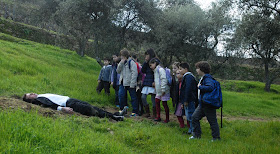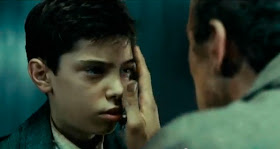What a privilege it was to see
ON THE EMPTY BALCONY (
En el balcón vacío) during the recent
Spanish Cinema Now series. This is a film that, though I had heard about it over the years -- always fleetingly, and with the caveat that no print still existed -- I never expected to be able to see. Now, thanks to the work of the
Film Society of Lincoln Center, presented in collaboration with
Instituto de la Cinematografia y de las Artes Audiovisuales (ICAA) of the Spanish Ministry of Culture and
Instituto Cervantes of New York, I have. While I say it was a privilege to view (and I mean this), it was also a bit of a disappointment.
Above: filmmaker and cast and crew, at the time (1961) of filming.
Granted, the print -- which we were lucky to have at all -- was not the best; even so, the film, at its hour length still offered a few too many
longueurs. A memory piece that shows us a grown women living in Mexico City who travels back to Spain to the home she lived in during the Spanish Civil War, which she and her family abdicated in the time after Franco's victory, the film is full of remembrances that glide, float and occasionally jolt.
The biggest jolt comes early on (this is one of the problems with the film), as our heroine, then a young girl, stands at one of the windows in their large apartment, when, across the courtyard, a man appears, carefully hanging on to the ledge of the building as he tries to make his escape from the authorities. He does it, too. Almost. Hiding beneath the cantilevered ledge, holding on for dear life, he escapes the gaze of the policemen who look downward but do not see him. A neighbor suddenly appears at her window and screams, "There he is! Get him! He's a
Red!" Her shrill, ugly, horrifying cry cuts through the gauzy memories like some new instrument of pain -- a combination sledge hammer and stilletto. The escaping man is caught, of course.
This brilliant scene encapsulates the frightening abuse of power that goes with everything from Spain's Civil War to our own country's less physically destructive but still disgusting McCarthy era and our current embrace of rendition and torture. Nothing that comes after this offers nearly the strength of that single scene, though there are some moving moments as the woman revisits her former home and eventually collapses into a heap as the memories rush over her. Compare this scene with a similar one in this year's SCN movie
Elisa K (also about the letting loose of repressed mem-ories) and note how far film has come over the last half-century.
Though there is some dialog, the movie is mostly voice-over, with the voice rather droning. As the FSLC's
Richard Peña pointed out during the Q&A, voice-over was being used by important filmmakers during the early 60s (this film was made in 1961).
Last Year at Marienbad is one example that pops into mind, but
Alain Resnais offered some sumptuous visuals to acccompany his movie's droning.
Balcony's views (with the exception of that single scene) are pretty prosaic. (
Elisa K also uses voice-over, but more interestingly and judiciously.)
The filmmaking techniques, from director
Jomí García Ascot, seem to my eye rather simple but appropriate enough. (The screenplay was co-written by the director, along with his actors
María Luisa Elio and
Emilio García Riera.) His film is impressionistic and its construction somewhat jagged, as might befit coming to terms with difficult memories (the loss of one's father, for instance). The leading actress (adult version), who looks wonderfully 60s, was the director's wife and mother of his son
Diego García Elio -- the man who introduced the film and followed its screening with a very interesting Q&A with Peña and audience members at the
Walter Reade Theater where the film was shown.
TrustMovies, his pen scrawling as fast as possible, took notes of as much of the conversation as he could. In the Q&A below,
questions appear in bold and Diego's answers in standard type
How did this film come together? was the first question asked of Diego -- who told us that his father was a member of group of Mexican filmmakers (including
Luis Buñuel!) involved with a film magazine called
Nuevo Cine. The film was a very personal one, with no budget. The actors were all friends -- either from Mexico or Spain (the film was shot entirely in Mexico -- on 16 mm) and the shooting was done on weekends. The story was based on real characters, though the return to Spain shown in the film, never actually happened for the real people on whom the film was based. But the director and actress (Diego's mom and dad) did indeed go back to Spain, and even wrote a book aboout this.
Was the film widely shown when it was first made? Just at two international festivals, Diego explained. It was never a commercial movie, though it did find some critical success. But it was never shown in Spain itself until the post-Franco era.
Did Diego's father continue with filmmaking after this one? Yes, he went to Cuba and became involved with the Cuban Institue of Filmmakers, and made two movies in that country.
What happened to the actress who played the little girl in the movie? (To TrustMovies' mind, she -- shown below -- is the most impressive performer in the film.) She only made this single film. She lives in Mexico currently and has her own family. But we have not kept in touch, and I really don't know her.
Was the heavy use of voice-overdone primarily for economic reasons?
Yes. But another reason is the sense of memory that voice-over provides. (Peña then reminded us that this was what Resnais and other filmmakers were doing at the time.)
(Directed to Peña) You refered to the movie as a masterpiece. Can you tell us what makes this a masterpiece?
It shows us something of the personal cost of the Spanish Civil war, and it was one of the first films to do this. I had heard about this film for such a long time, and when it was finally shown to me, it lived up to my every expectation.
Can you tell us something about the restoration of this movie and why, if it was restored, does it appear so grainy?
Because it was first shot on 16mm, it was considered an amateur production. Now, it has been blown up to 35mm, and consequently it has a more grainy look.
How does the movie differ from the family's actual story?
Well, the family was actually confined to a very small room during the war. And there were three little girls, not two, as shown in the film. The family escaped first to Barcelona, which was still a Republican stronghold at that time. When the Republic was lost, the family then went to Paris, where they were all together. Then, when WWII happened, they decided to move to Mexico. It's really another entire movie!
(Diego's dad, it turns out, was also an exile from Spain, and his grandfather's occupation was that of diplomat.)













































